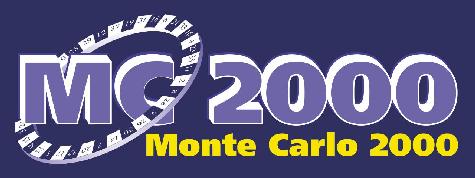

| FAQ on the use of LaTeX for MC2000 |
Why do we have to use LaTeX?
The proceedings of the
MC2000 conference will be published as a hardcover book + CDROM by Springer
Verlag. The whole editing process relies on the use of one single
formatting program and uniform layout of all contributions. Springer Verlag
decided to use the LaTeX package and supply the necessary style and document
class files. We are using these style files now also for the abstracts
in order to facilate the editing of an abstract book for the conference
and to avoid extra work for the participants due to the use of different
programs for abstracts and papers.
Where can I obtain LaTeX?
LaTeX is public domain software. Free packages can be downloaded from the following locations:
tug.ctan.org
(U.S.) - also has links to about 60 mirrors around the world
cam.ctan.org
(U.K.)
www.dante.de
(Germany)
Recommendation: Search for the file 1.20.zip - this is Miktex - a TeX/LaTeX package that is easy to install on the PC.
If your institution is
running main frame computers it is very likely that a LaTeX package is
already installed there. Please conctact your system administrator or simply
type the command latex and see if it is recognized.
Where can I get help on the use of LaTeX?
Documentation about LaTeX is provided at the locations above. However, if you are new to LaTeX a human expert will be more useful and since the use of LaTeX is widespread among scientists it is very likely that one or more "texperts" will exist at your institution.
If you really cannot get
any help at your institution contact the conference secretariat by e-mail
(mc2000@itn1.itn.pt)
but please be fair and remember that the person running the conference
secretariat is also only human.
Do I need extra files to compile my abstract file?
You have to download the document class and style files supplied by Springer Verlag and copy them to the directory where you want your *.tex files to reside. If you are a frequent user of LaTeX you can also put them into the base of your LaTeX system.
For your convenience the neccessary files are listed here (click on underlined file names to download):
svmult.cls
subeqnar.sty
physprbb.sty
cropmark.sty
How do I define the format of my abstract or paper?
The format of your abstract or paper is already fully defined by the document class and style files. You just have to replace the respective text parts in the sample files
abst.tex
(for abstracts)
author.tex
(for full papers)
using a standard text editor.
If you would like to see how the sample files look like after proccessing by LaTeX download these files:
Postscript format:
PDF format:
How do I create subscripts, superscripts, ... ?
LaTeX has a huge amount of commands to specify special characters, symbols, foreign letters and so on.
In the following the most common ones:
to make a subscript:
$\_{...}$
to make a superscript:
$\^{...}$
greek characters
$\alpha$, $\beta$, ... and for capital ones: $\Delta$, $\Phi$, ...
lower/equal
$\leq$
greater/equal
$\geq$
for other symbols it is always a good idea to try with $\symbol_name$, e.g., $\rightarrow$ creates an arrow pointing to the right. This trick works in many cases.
to make a reference in
the text:
\cite{...} with ... being
a name or similar produces an automatic numbering [1]..
to specify the reference
in the bibliography:
\bibitem{...} +++ with
... being the name above and +++ the reference itself
How do I include figures?
to insert a figure type in your *.tex file and replace "figure.eps" by the name of your file:
\begin{figure}[h]
\begin{center}
\includegraphics[width=.3\textwidth]{figure.eps}
% width=x specifies the width relative to the text width
\end{center}
\caption[]{Example of
an electronically included eps-figure}
\end{figure}
The figure has to be encapsulated
post script format for the compilation of the *.tex file. If you do not
know how to convert your figure into this format submit it in any other
common format together with the *.tex file and it will be processed by
us. In this case please make sure that the
file extension matches the standard.